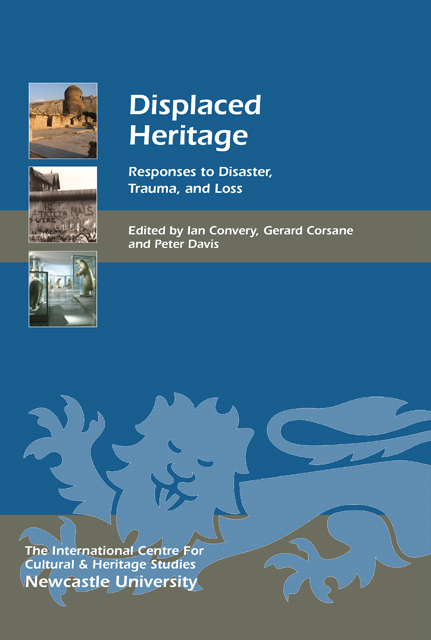Book contents
- Frontmatter
- Contents
- List of Illustrations
- Acknowledgments
- List of Abbreviations
- Preface
- Introduction
- Displaced Heritage: Histories and Tourism
- Displaced Heritage: Trauma, Confinement and Loss
- Displaced Heritage: Lived Realities, Local Experiences
- Displaced Natural Heritage
- Endpiece
- List of Contributors
- Index
- Heritage Matters
21 - Earthquakes: People, Landscape and Heritage in Japan
Published online by Cambridge University Press: 24 February 2023
- Frontmatter
- Contents
- List of Illustrations
- Acknowledgments
- List of Abbreviations
- Preface
- Introduction
- Displaced Heritage: Histories and Tourism
- Displaced Heritage: Trauma, Confinement and Loss
- Displaced Heritage: Lived Realities, Local Experiences
- Displaced Natural Heritage
- Endpiece
- List of Contributors
- Index
- Heritage Matters
Summary
In 1995 a major earthquake occurred in a densely populated area in the west of the main island of Japan. A year and a half later I met Ms Sakae, a 68-year-old woman who had become a refugee in the public shelter provided after the earthquake; I had worked there for six months as a volunteer, just after the earthquake hit (see Harada 2000). She related an episode that had taken place during a meeting of members at a house into which she had moved after spending three months at the shelter:
At a meeting of the refugees living in this temporary apartment, I said ‘It is not worth claiming against the municipal office about our condition here. It was our fault that we had our houses broken down by the quake. We ourselves had decided to live in such fragile houses.’ There was no one who opposed me.
Her remark was so unexpected that the other members were too surprised to reply. I re-examine this episode after discussing earthquakes, which themselves are a form of natural heritage in Japan, and suggest that her remark gets to the heart of the matter.
Earthquakes and Personal History
After telling me about the meeting in 1996, Ms Sakae went on to describe her experiences in 1945, at the end of World War II. She talked vividly about her experience during the war, describing a sight she had seen over 50 years earlier and then comparing the two experiences:
The next day, after the air raid, I walked around Osaka city searching for my friends. I saw a horse standing still, its skin was red.
In case of an air raid, we had an alarm, but we had no alarm in case of earthquake. My apartment was twisted and broken within seconds.
She had been born in 1927 in Osaka, where her father started a business in 1947. Sakae became ill aged 27 and was hospitalised for two years, and then in 1956 her father died. After leaving hospital she joined the family business with her two brothers; their business was very successful in the 1960s and 1970s, but in 1982 the company became bankrupt.
- Type
- Chapter
- Information
- Displaced HeritageResponses to Disaster, Trauma, and Loss, pp. 235 - 242Publisher: Boydell & BrewerPrint publication year: 2014



